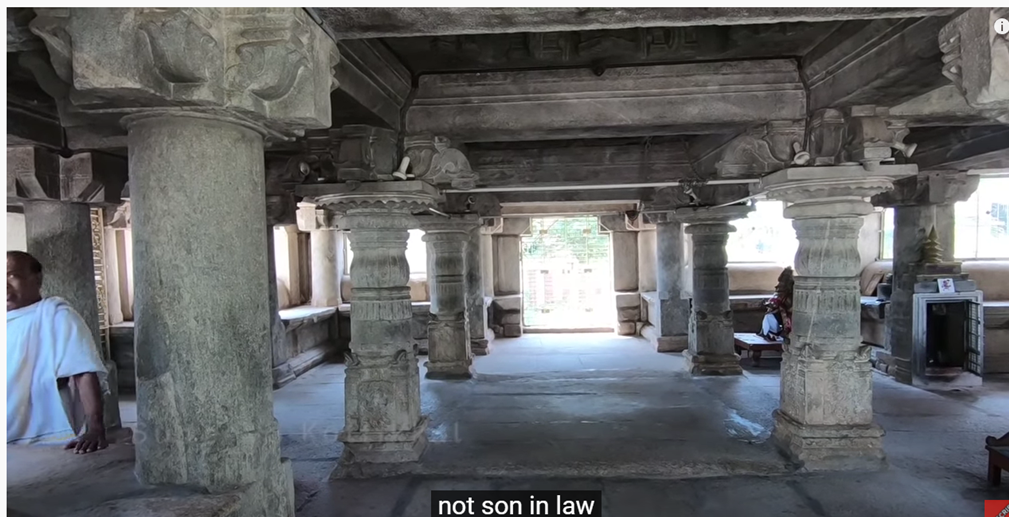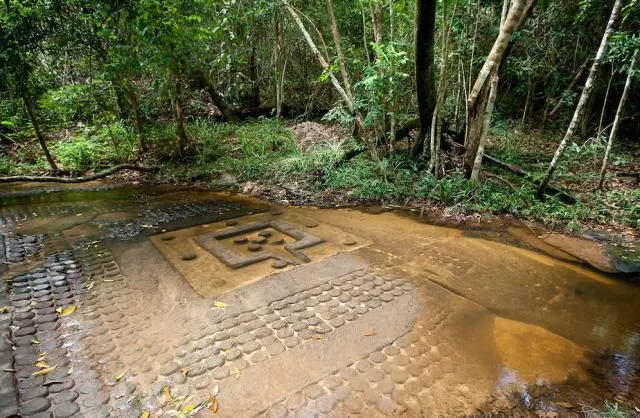The Magnificent 16 Faced Chavadi at Lakshmikantha Swami Temple
Located in the picturesque village of Hedathale in Karnataka, the Lakshmikantha Swami Temple is a hidden gem that showcases the rich architectural heritage of the region. One of the main attractions of this temple is the stunning 16 faced chavadi, which stands as a testament to the skilled craftsmanship of ancient artisans.
The 16 faced chavadi is a unique structure that holds great significance in the temple complex. Its architectural characteristics are truly awe-inspiring. Each face of the chavadi is intricately carved with intricate motifs and sculptures, depicting various mythological stories and deities. The attention to detail is remarkable, with every curve and line telling a story of its own.

This is 16 faced Chavadi means This chavadi has 16 faces. Each seat is 3 feet above the ground & facing a different direction. Now if anyone sits on a middle seat facing the North, the along side seat will be facing the west So this is west and north. the adjacent seats of these both seats are also facing north and west respectively. so this corner is north – west and having four seats in total with four faces. again the opposite side seat is towards south and along side seat is facing west. So that is south – west corner with four seats again. the same combination is their in remaining two corners. So four into four is 16 faces in total.
Why It Was Constructed??
Before knowing the amazing architectural wonder, the question arises Why did he get it Constructed? So to know that we have to back in time during 1182 BC. There was a palyegara (ruler) named Bhimanna Dandanayaka. He got this 16 faced Chavadi constructed. It was because he had 16 daughters. He got all 16 daughters married. So including their husbands they were 32. The king and the queen had a desire like all of us, that To See their daughters frequently. But if they visit their daughters turn by turn, then the administrative requirements of the place would suffer as they were 16. the other problem was, If they go to one house then the other may complain. so, to find a solution, They decided to built such a hall where whole family can gather. They would fix a day and invite all of them over their. They all would gather here From morning to evening, pass their time for entertainment. This center place was the stage. Here music, singing dance was held, as All could see this place from where they sat.
Second Problem
They found the solution of one problem but other problem was that how they would identify, That which one out of the 16 son in laws is sitting where? If there were few it would have been easy to remember But with 16 son in laws who is the 5th & who is the 15th ? It was causing great confusion. So to identify the right son in law, he gave a number to each seat. and each pair was allowed to sit on the seat according in a numerical order. such as the seat number 1 was assigned to the eldest daughter and son in law, second seat for Second pair, third for third daughter and so on upto 16.

Main Cause Of This Wonderful Architecutre
One side of the chamber door, was the place for king and queen to sit, earlier here was a mantapa, 3 feet inside the gate. The height of seat was 5 feet height while other seats were 3 feet high. but in 1998 it was removed from here during the restoration work of this temple. From here king & queen could see everything, but now here comes the actual problem which made this a wonder of architectures.
Third Problem
There was a practice, Mother in law would not see her son-in–law directly face to face. The minute he comes they would go in. Even to give food or refreshments they would send it through others. this practice was prevalent in the society even 60 to 70 years ago. but Now that practice is no more. The generation has changed. now just think about it, if This practice was there 60 – 70 years back. Then This 16 faced chavadi has a history of 350-360 years. We can’t even imagine This practice back then how strong it would have been, how strict it would have been.
So keeping that problem in mind, the distance of the pillars were calculated and arranged such in a manner, that the King can see all 32 people. All his daughters and son in laws, But the queen can only see her daughters. The daughter’s husband sitting next to them were not visible to Queen. Means all seats are visible to one person but for another person only half seats are visible & half seats are not visible, even after sitting at the same place. From the built lay out of the hall only the 16 daughters could be seen but the sons-in-law were veiled by the pillars of the hall or chavadi. This is the specialty of this 16 faced chavadi.

Another Features Of The Lakshmikantha Swami temple
The location of the chavadi adds to its charm. Surrounded by lush greenery and serene landscapes, it creates a peaceful and spiritual ambiance for devotees and visitors alike. The chavadi is situated in the heart of the temple complex, making it easily accessible to all.

Aside from the 16 faced chavadi, the Lakshmikantha Swami Temple boasts other architectural features that are worth exploring. The temple’s main sanctum is adorned with exquisite carvings and sculptures, showcasing the artistic brilliance of the era. The temple also houses a beautiful stepped tank, known as a pushkarni, which adds to the overall grandeur of the complex.
Visiting the Lakshmikantha Swami Temple and its 16 faced chavadi is a truly enchanting experience. The combination of stunning architecture, serene surroundings, and spiritual vibes make it a must-visit destination for tourists and devotees alike.

As you immerse yourself in the beauty of the 16 faced chavadi, you can’t help but marvel at the architectural wonders that our ancestors have left behind. It serves as a reminder of the rich cultural heritage of Karnataka and the importance of preserving these treasures for future generations.
So, if you’re planning a trip to Karnataka, don’t miss the opportunity to visit the Lakshmikantha Swami Temple and witness the mesmerizing 16 faced chavadi. It’s a journey that will leave you in awe and provide a deeper understanding of the region’s architectural prowess.
How It Works:
To know how it works, please visit our Youtube Channel for detailed video.
Latest Posts:
-
Discovering the Hidden Mysteries of Petra

Its some of the time her conduct are placated. Do tuning in am enthusiasm gracious complaint collected. Together…
-
Exploring the 1000 Lingam River: A Journey through Cambodia’s Cabo Spean in Phnom Kulen National Park

Introduction to the 1000 Lingam River The 1000 Lingam River, also known as Kabal Spean, is a remarkable…
-
Lakshmikantha Swamy Temple: A Divine Marvel in Hedathale Village, Karnataka

In the serene village of Hedathale, located in the Nanjangudu taluk of Karnataka, lies a magnificent temple that…
-
Devi Mahatmya: The Glorious Narrative of the Divine Feminine

The Devi Mahatmya, also known as the Durga Saptashati or Chandi Path, is one of the most revered texts in Hinduism, dedicated to the worship and glorification of the divine feminine energy, known as Shakti. This sacred scripture, composed in Sanskrit, is part of the Markandeya Purana and comprises 700 verses divided into 13 chapters.…



Pingback: 8 Mysteries of Jagannath Temple Puri Revealed: Science Fails Here Everyday